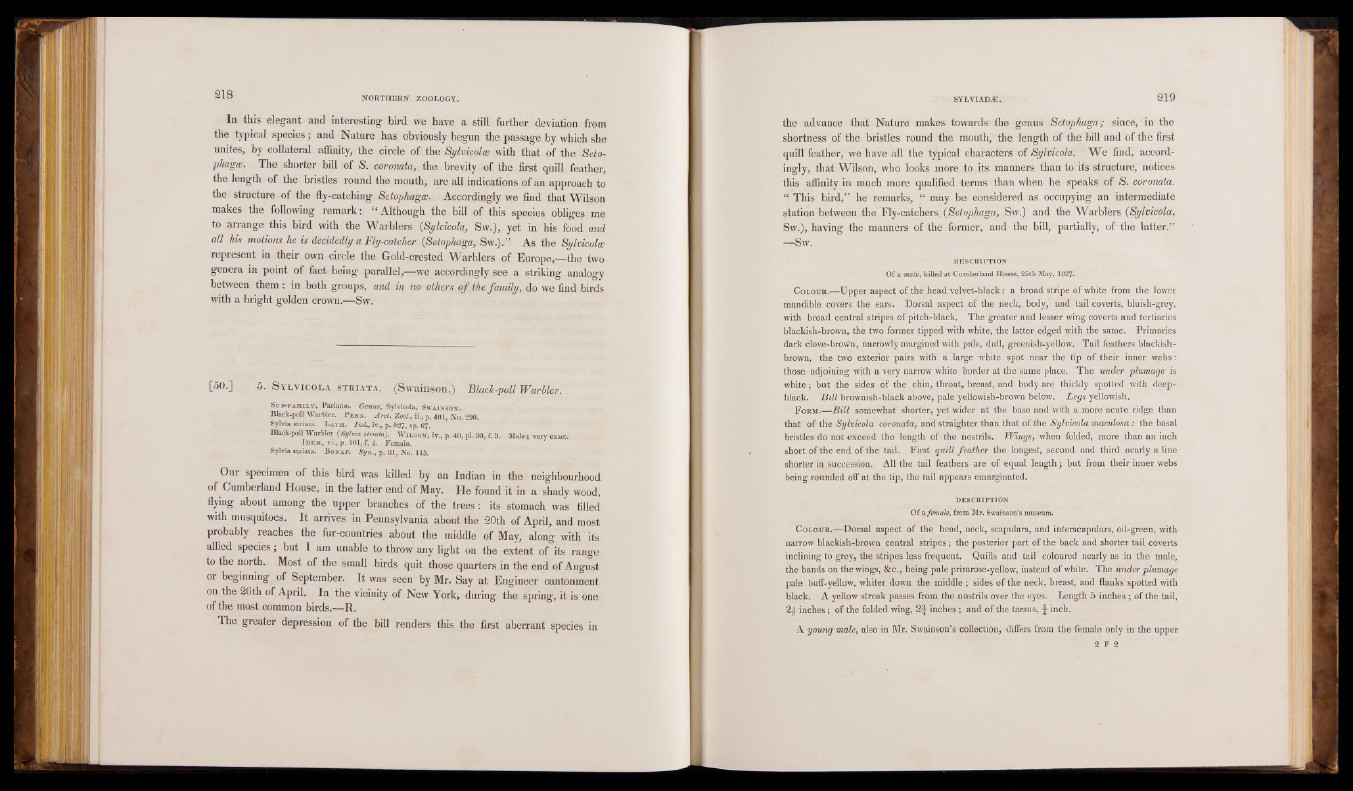
In this elegant and interesting bird we have a still further deviation from
the typical species; and Nature has obviously begun the passage by which she
unites, by collateral affinity, the circle of the Sylvicola; with that of the Seto-
phagce. The shorter bill of S. coronata, the brevity of the first quill feather,
the length of the bristles round the mouth, are all indications of an approach to
the structure of the fly-catching Setophagce. Accordingly we find that Wilson
makes the following remark: “ Although the bill of this species obliges me
to arrange this bird with the Warblers (Sylvicola, Sw.), yet in his food and
all his motions he is decidedly a Fly-catcher (Setophaga, Sw.).'H. As the Sylvicolce
represent in their own circle the Gold-crested Warblers of Europe,—the two
genera in point of fact being parallel,m-we accordingly see a striking analogy
between them : in both groups, and in no others o f the family, do we find birds with a bright golden crown.—Sw.
[50.] 5. S y l v i c o l a s t r i a t a . (Swainson.) Black-poll Warbler.
Sub-f a m il y , Parians. Genus, Sylvicola, Sw ain so n .
Black-poll Warbler. P e n n . Arct. Zool., ii., p. 401, No. 290.
Sylvia striata. L a t h . Ind., iv., p. 527, sp. 67.
Black-poll Warbler (Sylvia striata). W il so n , iv., p. 40, pi. 30, f. 3. Male; very exact.
I d em , vi.,p. 101, f. 4. Female.
Sylvia striata. Bo nap. Syn., p. 81, No. 115.
Our specimen of this bird was killed by an Indian in the neighbourhood
of Cumberland House, in the latter end of May. He found it in a shady wood,
flying about among the upper branches of the trees : its stomach was filled
with musquitoes. It arrives in Pennsylvania about the 20th of April, and most
probably reaches the fur-countries about the middle of May, along with its
allied species; but I am unable to throw any light on the extent of its range
to the north. Most of the small birds quit those quarters in the end of August
or beginning of September. It was seen by Mr. Say at Engineer cantonment
on the 26th of April. In the vicinity of New York, during the of the most common birds.—R. spring, it is one
The greater depression of the bill renders this the first aberrant species in
the advance that Nature makes towards the genus Setophaga; since, in the
shortness of the bristles round the mouth, the length of the bill and of the first
quill feather, we have all the typical characters of Sylvicola. We find, accordingly,
that Wilson, who looks more to its manners than to its structure, notices
this affinity in much more qualified terms than when he speaks of S. coronata.
“ This bird,” he remarks, “ may be- considered as occupying an intermediate
statiqn between the Fly-catchers (Setophaga, Sw.) and the Warblers (Sylvicola,
Sw.), having the manners of the former, and the bill, partially, of the latter.”
—Sw.
DESCRIPTION
Of a male, killed at Cumberland House, 25th May, 1827*
C olour.—Upper aspect of the head velvet-black: a broad stripe of white from the lower
mandible covers the ears. Dorsal aspect of the neck, body, and tail coverts, bluish-grey,
with broad central stripes of pitch-black. The greater and lesser wing coverts and tertiaries
blackish-brown, the two former tipped with white, the latter edged with the same. Primaries
dark clove-brown, narrowly margined with pale, dull, greenish-yellow. Tail feathers blackish-
brown, the two exterior pairs with a large white spot near the tip of their inner webs:
those adjoining with a very narrow white border at the same place. The under plumage is
white; but the sides of the chin, throat, breast, and body are thickly spotted with deep-
black. Bill brownish-black above, pale yellowish-brown below. Legs yellowish.
F orm.—Bill somewhat shorter, yet wider at the base and with a more acute ridge than
that of the Sylvicola coronata, and straighter than that of the Sylvicola maculosa : the basal
bristles do not exceed the length of the nostrils. Wings, when folded, more than an inch
short of the end of the tail. First quill feather the longest, second and third nearly a line
shorter in succession. All the tail feathers are of equal length; but from their inner webs
being rounded off at the tip, the tail appears emarginated.
DESCRIPTION
Of a female, from Mr. Swainson’s museum.
C o lo u r .—Dorsal aspect of the head, neck, scapulars, and interscapulars, oil-green, with
narrow blackish-brown central stripes; the posterior part of the back and shorter tail coverts
inclining to grey, the stripes less frequent. Quills and tail coloured nearly as in the male,
the bands on the wings, &c., being pale primrose-yellow, instead of white. The under plumage
pale buff-yellow, whiter down the middle ; sides of the neck, breast, and flanks spotted with
black. A yellow streak passes from the nostrils over the eyes. Length 5 inches ; of the tail,
inches; of the folded wing, 2£ inches ; and of the tarsus, f inch.
A young male, also in Mr. Swainson’s collection, differs from the female only in the upper
2 F 2